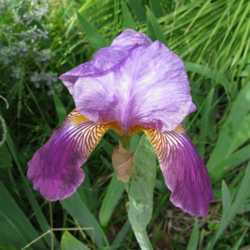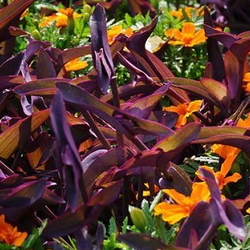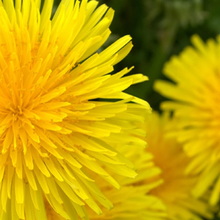 Purple Heart pairs nicely with purple flowered plants. Pairing analogous colors that are close together on the color wheel gives a harmonious and subtle effect. The purple neighbors seem to intensify each other. Some highly resiliant combinations include Purple Heart with Mexican Petunia (Ruellia brittonia), Fan Flower (Scaevola aemula) (pictured) and purple-flowered lantana (Lantana montevidensis 'Trailing Lavender'). Persian shield (Strobilanthes dyerianus) has lovely purple foliage that works well.
Purple Heart pairs nicely with purple flowered plants. Pairing analogous colors that are close together on the color wheel gives a harmonious and subtle effect. The purple neighbors seem to intensify each other. Some highly resiliant combinations include Purple Heart with Mexican Petunia (Ruellia brittonia), Fan Flower (Scaevola aemula) (pictured) and purple-flowered lantana (Lantana montevidensis 'Trailing Lavender'). Persian shield (Strobilanthes dyerianus) has lovely purple foliage that works well.
 | Red is also close to reddish purple on the color wheel. I have seen bright red flowered hibiscus and fire spike (Odontonema strictum) paired with Purple Heart in my neighborhood. For me however, this combo doesn't work possibly because the nearby bright red brings out the red undertones in Purple Heart and reminds me of, well, liver. When using a theoretical color scheme, personal taste still comes into play. One way to test a potential color combo is to get a pot of healthy plant and set it next to a possible companion and see if you like it. I like to assemble test groups of potted plants together at the nursery before I buy. |

|
| I   f two pure colors are a bit much next to each other, maybe a toned down version of one will work. Each color on the wheel also comes with tints, tones and shades made by mixing white, grey or black respectively with the color. Tints, tones and shades are often less intense than the pure version of the color. Pink is a tint of red (red + white) that works quite well with Purple Heart. In fact, nature has picked pink flowers as a highlight for it’s red-purple foliage. The more intense pink flowers of four o’clock (Mirabilis jalapa), coneflowers (Echinacea purpurea) and Sunshine Mimosa (Mimosa strigillosa) (pictured) also sparkle when next to Purple Heart. Of course the classic, “just go ahead and try to kill us” parking lot combination is with Madagascar Periwinkle, (Vinca or Catharanthus roseus) Burgundy and rusts are shaded reds that works well adjacent to Purple Heart. Knot weed (Persicaria microcephala 'Red Dragon') and burgandy accented versions of Coleus or Canna pair nicely with Purple Heart. f two pure colors are a bit much next to each other, maybe a toned down version of one will work. Each color on the wheel also comes with tints, tones and shades made by mixing white, grey or black respectively with the color. Tints, tones and shades are often less intense than the pure version of the color. Pink is a tint of red (red + white) that works quite well with Purple Heart. In fact, nature has picked pink flowers as a highlight for it’s red-purple foliage. The more intense pink flowers of four o’clock (Mirabilis jalapa), coneflowers (Echinacea purpurea) and Sunshine Mimosa (Mimosa strigillosa) (pictured) also sparkle when next to Purple Heart. Of course the classic, “just go ahead and try to kill us” parking lot combination is with Madagascar Periwinkle, (Vinca or Catharanthus roseus) Burgundy and rusts are shaded reds that works well adjacent to Purple Heart. Knot weed (Persicaria microcephala 'Red Dragon') and burgandy accented versions of Coleus or Canna pair nicely with Purple Heart. |
| | Complementary colors are opposite the color wheel and paired together can make a bold statement. Across the color wheel from reddish purple is chartreuse. Chartreuse is quite bright and can easily be overwhelming however, it can brighten a shady spot in the garden. Several vigorous chartreuse ground covers are available to duke it out with Purple Heart including Creeping Jenny (Lysimachia nummularia) and sweet potato vine ( Ipomoea batatas 'Margarita') (pictured). Chartreuse Coleus varieties are a better-behaved option. |
| | I have always loved the combination of Purple Heart and orange flowers. A triadic color scheme is the theoretical explanation. This color scheme uses a triad of colors equidistant the color wheel; in this case; red-purple, marigold (Orange/yellow) and aqua (blue/green). My favorite spot in the garden this spring contained Diascia barberae 'Flying Colors Coral' and Purple Heart. Marigolds, Crossandra infundibuliformis (pictured) Gaillardia aristata 'Oranges and Lemons' and Gazania krebsiana 'Tanager’ might also be attractive orange flowered choices. Coleus also has some orange leaved varieties. |
| | Certain foliage plants can be used for the aqua note including various agaves, Ajuga reptans 'Burgundy Glow' (pictured below), junipers, the blue phase of saw palmetto (Sereno repens), cuban oregano (Plectranthus amboinicus 'Wedgewood') and fescues. Blue Daze (Evolvulus glomeratus) which has green/blue foliage and small blue flowers is another option. Many plants with grey/green foliage have a dusty, muted quality that compliments the muted grey/blue sheen on Purple Heart’s leaves. |
Color is never the only issue when combining plants. The new neighbors also need to have similar soil and water requirements. An aggressive companion can easily overrun a delicate little plant. Purple Heart should either be trimmed back regularly or be grown adjacent to plants that can hold their own. It spreads vigorously, self-seeds and is considered invasive by some. Check your State’s invasive plants list before choosing for your garden. Purple heart is not too choosey about location and can be in full sun to part shade, acid or alkaline soil. In fact, South of a freeze, it is as tough as nails. It's a good candidate to the sidewalk strip so, why not pull out that struggling grass and experiment with color?
(Editor's Note: This article was originally published September 13, 2009. Your comments are welcome, but please be aware that authors of previously published articles may not be able to respond to your questions.)




















